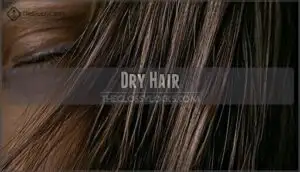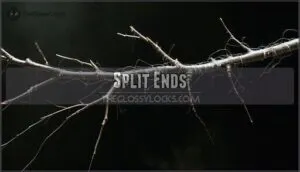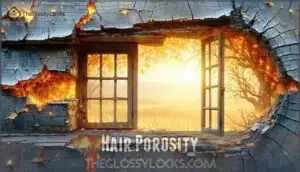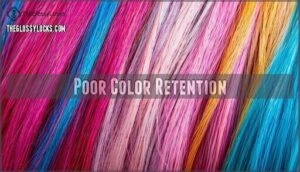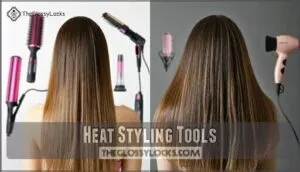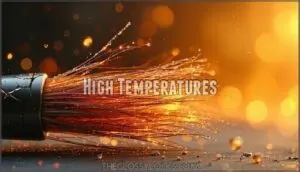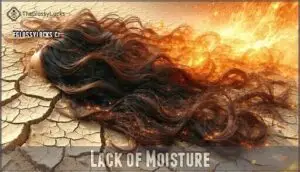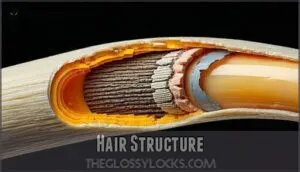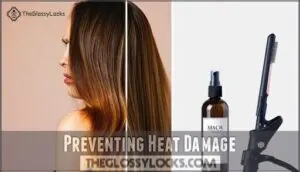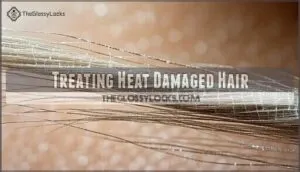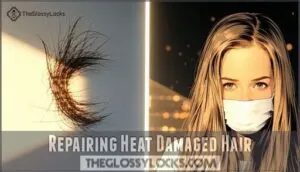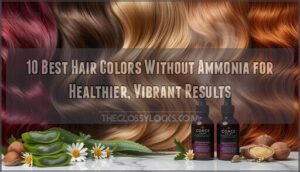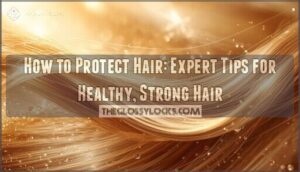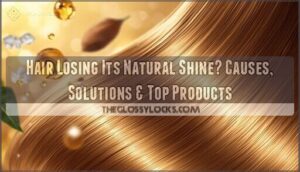This site is supported by our readers. We may earn a commission, at no cost to you, if you purchase through links.
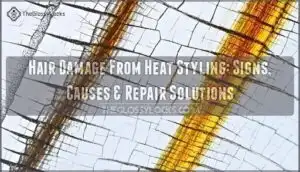
This process destroys the protective cuticle layer, causing moisture loss and weakening the hair shaft. You’ll notice dryness, split ends, increased porosity, and color fading.
Hot tools like flat irons, curling irons, and blow dryers are the main culprits, especially when used frequently without protection. The damage happens at a molecular level, making your hair brittle and prone to breakage.
While completely reversing heat damage isn’t possible, strategic treatments can substantially improve your hair’s appearance and prevent further deterioration through targeted repair methods.
Table Of Contents
- Key Takeaways
- What is Heat Damage
- Signs of Heat Damaged Hair
- Causes of Heat Damage
- Preventing Heat Damage
- Treating Heat Damaged Hair
- Repairing Heat Damaged Hair
- Frequently Asked Questions (FAQs)
- How do you fix damaged hair from heat?
- How can I style my hair with heat without damaging it?
- What does damaged hair from heat look like?
- Will hair grow back from heat damage?
- Can heat damage cause permanent hair loss?
- How long does heat damage take to occur?
- What temperature is considered safe for styling?
- Can heat damage reverse itself over time?
- Conclusion
Key Takeaways
- You’ll damage your hair’s protein structure when styling above 300°F – High temperatures convert healthy α-keratin to damaged β-keratin, creating irreversible changes that weaken your hair shaft and cause breakage.
- Heat protectant spray isn’t optional if you’re using hot tools – These products create a barrier against temperatures up to 450°F, but you’ll still need to keep settings below 300°F for fine hair and 350°F for thick hair.
- You can’t reverse heat damage, but you can improve your hair’s appearance – Regular trims every 6-8 weeks, deep conditioning treatments, and protein masks will restore moisture and prevent further deterioration.
- Your hair needs breaks from heat styling to recover – Embrace air drying, protective styles, and heatless methods while damaged strands rebuild their moisture barrier and structural integrity.
What is Heat Damage
Heat damage occurs when high temperatures from styling tools break down your hair’s protein structure and strip away essential moisture.
You’ll notice this damage through dryness, split ends, and that frustrating frizz that seems impossible to tame.
Protein Denaturation
Every strand of your hair is built from keratin proteins that act like tiny molecular scaffolds.
When heat styling tools exceed 140°C, these protein structures begin breaking down through denaturation process, fundamentally altering your hair’s molecular damage resistance. Heat can also cause oxidative stress on the hair and scalp.
Here’s what happens during keratin breakdown:
- Protein structure shifts – Your hair’s α-keratin converts to weaker β-sheet formations
- Hair protein bonds snap – Disulfide and hydrogen bonds that provide strength deteriorate
- Hair weakening accelerates – Tensile strength drops substantially, making strands fragile
- Molecular damage spreads – Once denatured, keratin proteins can’t return to their original form
Moisture Loss
Dehydrating your hair through heat styling strips away its natural moisture barrier, leaving strands vulnerable to breakage.
High temperatures evaporate water molecules from the hair shaft, disrupting the cortex’s delicate hydration balance. This oil depletion reduces elasticity and increases porosity impact, making your hair brittle and prone to environmental factors damage.
| Temperature Range | Moisture Loss Effect | Recovery Time |
|---|---|---|
| 200-250°F | Minimal dehydration | 1-2 days |
| 300-350°F | Moderate water loss | 3-5 days |
| 400°F+ | Severe moisture depletion | 1-2 weeks |
| Daily heat styling | Chronic dryness | Ongoing damage |
Heat styling without proper hydration methods or heat protectant accelerates this moisture loss, creating a cycle of hair damage that requires intensive restoration efforts.
Cuticle Damage
Heat styling damages your hair cuticle, the protective outer layer that guards against moisture loss and protein damage.
When exposed to high temperatures, cuticles crack and lift, creating rough texture and reducing shine.
Heat transforms your hair’s protective cuticles into cracked shields, stealing shine and smoothness.
This cuticle lifting disrupts your hair’s natural moisture barrier, leaving strands vulnerable to further heat styling damage and requiring targeted hair damage repair treatments.
Formation of Free Radicals
When your styling tools reach extreme temperatures, they trigger free radicals—unstable molecules that attack hair proteins.
This oxidative stress overwhelms your hair’s natural antioxidant defense system, causing cellular damage throughout the strand.
Environmental factors like pollution amplify this radical propagation, accelerating heat damage and weakening your hair’s structural integrity from within.
Colour Fading
Color-treated hair fades faster when you crank up those heat styling tools.
High temperatures accelerate chemical processes that break down melanin pigments, especially after UV exposure or bleaching.
Your hair’s increased porosity effects make it harder to lock in color molecules.
Without proper color protection products, heat styling tools cause irreversible hair damage and premature fading.
Signs of Heat Damaged Hair
You’ll know your hair is crying out for help when those telltale signs start showing up after your styling sessions.
Heat damage manifests through dry, brittle strands that snap easily, split ends that seem to multiply overnight, persistent frizziness, increased porosity that makes your hair drink up moisture like a sponge, and color that fades faster than your summer tan.
The signs of heat damage can be quite distressing, including split ends that seem to multiply overnight, and the overall deterioration of hair health.
Dry Hair
Your scalp produces natural oils that act like a protective shield, but heat styling tools strip away this moisture faster than you can say "bad hair day."
When your hair lacks proper hydration, it becomes brittle and rough. Reducing shampoo frequency helps preserve natural oils, while humectant use and oil treatments restore moisture balance.
Heat protectant spray creates a barrier against hair damage during styling, supporting scalp health and effective hair breakage prevention through targeted hydration methods. To test this, consider performing a hair strand test.
Split Ends
Beyond dryness, you’ll notice split ends appearing as your hair’s protein structure weakens from heat styling tools. These damaged tips signal that heat protectant spray wasn’t enough to shield your strands.
Identifying Causes of split ends:
- Split End Types – Look for white nodules, Y-shaped splits, or feathered ends indicating varying degrees of hair breakage
- Preventing Splits – Temperature settings above 300°F cause irreversible keratin damage, making prevention essential
- Trimming Techniques – Regular cuts every 6-8 weeks stop splits from traveling up the hair shaft
- Repairing Split ends requires professional intervention since damaged bonds can’t naturally heal through hair damage prevention alone
Frizziness
Heat styling damage leaves your hair looking like it’s been through a windstorm – constantly frizzy and unmanageable.
When heat breaks down your hair’s protective cuticle layer, the strands can’t align properly, creating that frustrating frizz you’re battling.
Humidity effects worsen the situation, making damaged hair absorb moisture unevenly, which helps in understanding frizz causes to choose the right frizz products to manage frizz effectively.
Hair Porosity
Think of your hair cuticle like a window – when heat styling damage occurs, those protective layers crack open, creating gaps that drastically increase hair porosity.
High porosity levels mean your strands absorb products quickly but can’t retain moisture effectively.
This increased heat sensitivity makes your hair vulnerable to further damage, affecting the cuticle’s compromised state and turning moisture retention into an uphill battle against persistent dryness.
Poor Color Retention
Heat-damaged hair often struggles to hold onto color, leaving your vibrant dye looking dull and faded.
Color fading causes stem from dye molecule damage when heat styling tools break down pigment bonds.
Your hair’s increased porosity allows color to escape more easily, especially after UV exposure compounds the problem.
This makes color-safe products and thermal hair care essential for protecting your hair color investment.
Causes of Heat Damage
Understanding what causes heat damage helps you protect your hair from irreversible harm.
Your styling tools, temperature settings, hair’s natural moisture levels, and individual hair structure all play key roles in determining damage risk.
Heat Styling Tools
Every day, millions reach for flat irons, curling irons, and blow dryers without realizing these heat styling tools can damage up to 85% of hair’s keratin proteins.
Tool temperatures exceeding 300°F cause irreversible changes, while poor tool materials and usage techniques amplify hair straightening damage, hair curling damage, and hair dryer damage.
Consistent use of these tools can increase the risk of damage. Heat protectants offer essential protection, though alternative tools provide safer styling options.
High Temperatures
Your styling tools become weapons when temperature thresholds exceed 300°F.
Protein breakdown occurs rapidly above this point, causing irreversible damage to your hair’s keratin structure.
Wet hair is particularly vulnerable—water turns to steam at lower temperatures, creating internal pressure that fractures strands.
Using quality protective sprays can mitigate these effects.
Tool material and high temperatures combine to strip protective oils, leaving your hair defenseless against heat damage from future styling sessions.
Lack of Moisture
Insufficient hair moisture creates a perfect storm for heat styling damage. When your hair lacks proper hydration, it becomes more vulnerable to thermal injury and protein breakdown. Dry strands can’t withstand high temperatures like well-moisturized hair can.
Here’s how moisture deficiency amplifies heat damage:
- Weakened protein bonds – Dehydrated keratin structures break down faster under heat
- Increased porosity – Dry cuticles lift more easily, allowing moisture to escape rapidly
- Compromised barrier function – Without natural oils for protection, heat penetrates deeper into the hair shaft
Poor scalp health and inadequate oil replenishment contribute to this cycle. Your hair needs consistent hydration methods and moisture retention strategies. Consider using specialized hair products for ideal results. Using humectant-rich products can help, but prevention through proper hair protection remains key.
Hair Structure
Understanding your hair’s architecture helps explain why heat wreaks havoc.
Your hair shaft contains three layers: the medulla (innermost core with Medulla Function for structural support), the cortex (middle layer rich in Cortex Composition including keratin proteins and melanin), and protective Cuticle Layers outside.
Heat alters these hair proteins’ molecular structure, transforming strong α-keratin into weaker β-keratin, compromising your hair’s protein structure and causing widespread hair cuticle damage.
Addressing this damage early with proper care is important because some hair damage can be reversed.
Preventing Heat Damage
Prevention starts before you even plug in your styling tools—choosing the right temperature settings can mean the difference between healthy hair and damaged strands.
You’ll also need heat protectants, gentle care routines, and strategic breaks from heat styling to keep your hair’s protein structure intact, which is crucial for maintaining healthy hair.
Choosing Right Tools
When selecting hair styling tools, prioritize ceramic or titanium tool material for even heat distribution.
Temperature control features let you adjust settings below 300°F for fine hair. Size matters—choose barrel diameter matching your desired curl pattern.
Quality tool features like ionic technology reduce frizz. Consider exploring options for ceramic coated tools for even heat distribution.
Budget options still offer essential temperature controls for safer hair styling practices, using temperature control and quality tool features.
Using Heat Protectants
Beyond selecting the right tools, you’ll need thermal heat protectant products to create an effective heat barrier.
These hair protection products contain specialized protectant ingredients like silicones and polymers that shield your strands from damage.
Application techniques for maximum protection:
- Spray evenly on damp hair from mid-length to ends
- Wait 30 seconds before applying heat styling tools
- Use quarter-size amounts for shoulder-length hair
- Reapply between multiple styling passes
Most heat protectants guard against temperatures up to 450°F.
For ideal heat styling safety, choose product types based on your hair texture and reapplication frequency needs during styling sessions.
Gentle Hair Care
Gentle detangling with wide-tooth combs protects fragile strands from breakage.
Silk pillowcases reduce friction while you sleep, preserving your hair’s moisture barrier.
Natural brushes distribute scalp oils evenly, promoting scalp health.
Air drying whenever possible eliminates additional heat exposure.
Remember to protect from sun with UV products.
Choose hydrating ingredients like argan oil in your daily routine—your hair will thank you for this gentler approach to styling, which helps maintain your hair’s natural beauty with argan oil.
Reducing Heat Styling
Cutting back on heat styling is like giving your hair a vacation. Try air drying, protective styles, or heatless methods to embrace your natural texture.
Swap out daily hot tools for styling alternatives—your strands will thank you. Use a heat protectant when you must style.
These hair damage prevention tips help maintain healthy hair and reduce breakage, which is a key part of giving your hair a break.
Treating Heat Damaged Hair
Once heat damage sets in, you’ll need a targeted approach to restore your hair’s health and prevent further deterioration.
The key is combining immediate repair treatments with long-term protective strategies to rebuild your hair’s structural integrity.
Trimming
Regular trimming remains your strongest defense against heat damage progression.
You can’t repair split ends once they form—they’ll continue traveling up the hair shaft like a run in stockings.
Schedule professional trimming every 6-8 weeks, or master home trimming techniques using sharp hairdressing scissors.
This split end prevention strategy stops further hair damage and maintains healthier-looking hair.
Deep Conditioning
Deep conditioning restores moisture and nourishment to heat-damaged hair follicles through intensive hydration therapy.
These treatments penetrate the cortex, replenishing water bonds broken during heat exposure.
Apply hair masks with shea butter or argan oil weekly, focusing on mid-lengths and ends.
DIY conditioners using coconut oil create effective overnight masks.
Proper application techniques enhance ingredient benefits while supporting scalp health and hair repair.
Protein Treatments
Protein-powered hair repair starts with keratin replenishment, rebuilding your hair’s damaged protein structure from within.
These treatments use hydrolyzed proteins like collagen and silk amino acids through various application methods—deep treatments, rinse-outs, or leave-ins.
Treatment frequency matters; overdoing it causes stiffness. When used correctly, expect increased hair strength and reduced breakage within weeks, leading to overall hair strength.
Avoiding Heat Styling
While your hair recovers, embrace air drying and protective styles like braids or buns.
These heatless methods preserve natural texture while promoting hydration focus.
Skip the flat iron completely—your strands need time to rebuild their protein structure.
Heat free styling prevents further cuticle damage, allowing moisture to return naturally and restoring your hair’s strength.
For defined curls, consider using twist-out methods.
Repairing Heat Damaged Hair
When your hair suffers heat damage, you don’t have to accept brittle, lifeless strands as your new reality.
Repairing heat-damaged hair requires targeted treatments that restore moisture, rebuild protein structure, and seal the cuticle to return your hair to its healthy state.
Hair Masks
Think of hair masks as a rescue mission for heat damage.
They deliver deep conditioning, target hair damage repair, and boost shine.
Try these options for relief:
- DIY Masks with avocado or honey
- Protein-rich Mask Ingredients for strength
- Lightweight Mask Types for fine hair
- Weekly Mask Frequency for best results
- Overnight Masks for intense hydration
Your hair will thank you for using these hair masks!
Leave-in Treatments
Beyond masks, leave-in treatments offer round-the-clock hair protection without rinsing.
These lightweight formulas penetrate damaged cuticles, delivering sustained moisture and protein repair.
Application techniques vary—spray evenly on damp hair, focusing on mid-lengths and ends where heat damage concentrates most severely.
| Treatment Type | Key Benefits | Best Application |
|---|---|---|
| Keratin Sprays | Rebuilds protein bonds | Damp hair, pre-styling |
| Oil Serums | Seals moisture, adds shine | Dry ends, overnight |
| Cream Formulas | Deep hydration, frizz control | Towel-dried lengths |
| Heat Protectants | Shields from styling damage | Before heat tools |
Ingredient analysis reveals ceramides and amino acids restore structural integrity, while natural oils create protective barriers.
Product selection depends on your hair’s porosity—fine hair needs lightweight mists, while coarse textures benefit from richer creams.
Overnight treatments work while you sleep, maximizing repair time.
Professional Help
When damage runs deep, seeking Expert Consultation becomes essential.
A hair specialist can provide thorough hair damage assessment, identifying issues invisible to untrained eyes.
Professional Products containing concentrated keratin and ceramides offer Advanced Repair beyond store-bought options.
Trichologist visits guarantee Specialized Care through customized hair treatment plan development targeting your specific damage patterns.
DIY Remedies
From your pantry to your hair, natural kitchen ingredients can rescue damaged strands.
Homemade masks using avocado, honey, and coconut oil provide deep conditioning.
Herbal rinses with green tea reduce oxidative stress.
Overnight treatments with natural oils seal moisture into compromised cuticles.
These DIY remedies offer temporary improvement for heat damage while supporting your hair care routine.
Long-term Hair Care
While DIY treatments offer temporary relief, sustainable hair recovery requires consistent long-term commitment. Your scalp health forms the foundation – massage weekly to boost circulation.
Diet impact matters too; protein-rich foods fuel hair strength restoration.
- Hydration habits: Drink water consistently for internal moisture retention
- Protective styles: Minimize manipulation with gentle braids or buns
- Routine adjustments: Switch to sulfate-free products permanently
- Prevention strategies: Never skip heat protectants, even for quick touch-ups
Frequently Asked Questions (FAQs)
How do you fix damaged hair from heat?
You’ll need regular trims, deep conditioning treatments, protein masks, and heat protectants.
Skip heat styling temporarily, use sulfate-free shampoo, and apply leave-in treatments to restore moisture and repair damaged keratin bonds.
How can I style my hair with heat without damaging it?
Picture your hair cuticles like delicate flower petals—they need gentle handling to stay smooth.
Use heat protectant sprays, keep temperatures below 300°F, and style on nearly-dry hair to prevent steam damage.
What does damaged hair from heat look like?
Heat-damaged hair shows telltale signs you can’t miss: split ends, rough texture, excessive dryness, and breakage. You’ll notice dullness, frizz, and hair that snaps when touched or brushed.
Will hair grow back from heat damage?
Coincidentally, your hair follicles remain unaffected by surface heat damage. Hair grows from roots beneath your scalp, so new growth emerges healthy while damaged sections need trimming.
Can heat damage cause permanent hair loss?
Heat damage typically doesn’t cause permanent hair loss from the follicle, but it can severely weaken strands, leading to excessive breakage that mimics hair loss until healthy hair regrows.
How long does heat damage take to occur?
Like a frying pan on high heat, your hair’s proteins start breaking down within seconds of exposure to temperatures above 300°F, with irreversible damage occurring almost immediately.
What temperature is considered safe for styling?
You’re safest keeping styling tools below 300°F for fine hair and under 350°F for thick hair. Temperatures above 356°F cause irreversible protein damage, so err on the cooler side.
Can heat damage reverse itself over time?
Unfortunately, heat damage can’t reverse itself naturally.
Once keratin proteins undergo structural changes from high temperatures, they’re permanently altered.
You’ll need protein treatments, deep conditioning, and regular trims to restore hair health.
Conclusion
Think of your hair like a beautiful silk scarf that’s been through the washing machine too many times – it starts strong but gradually loses its luster and integrity.
Hair damage from heat styling affects over 90% of women who regularly use hot tools, yet understanding the science behind protein denaturation and cuticle disruption empowers you to make better choices.
You can’t completely reverse heat damage, but consistent protective measures, proper treatments, and strategic styling adjustments will restore your hair’s health and prevent future deterioration.
- https://soldejaneiro.com/blogs/hair-care/the-impact-of-heat-styling-on-hair-health
- https://www.dyson.com/discover/insights/hair/health/heat-damaged-hair-causes-treatments-and-prevention
- https://www.livingproof.com/blogs/hair-101/heat-damaged-hair
- https://www.triprinceton.org/post/hair-heat-protection-claim-support-101
- https://www.k18hair.com/blogs/consumer/science-class-17-the-science-behind-heat-damage

